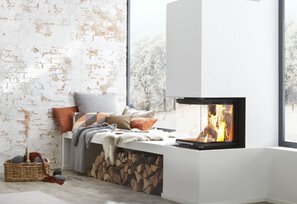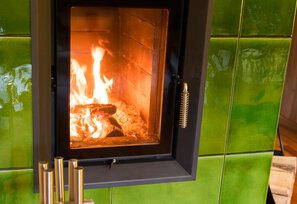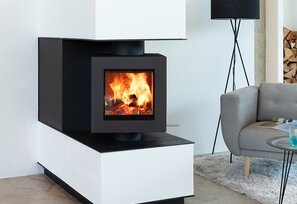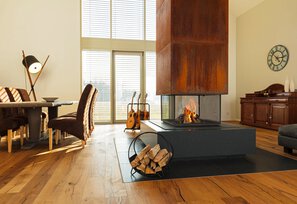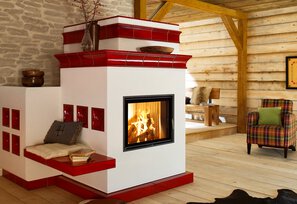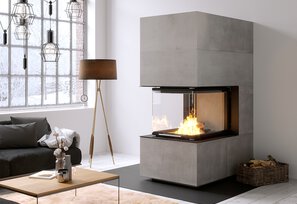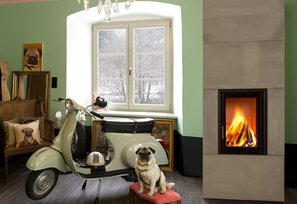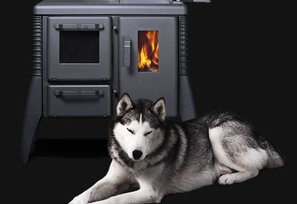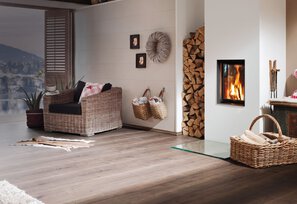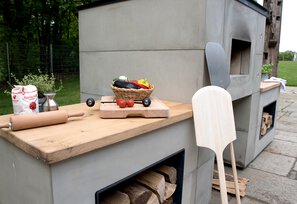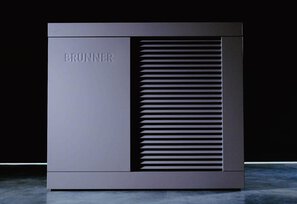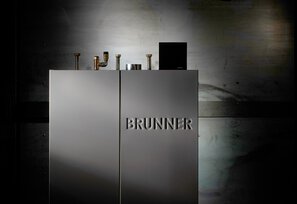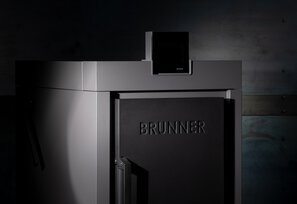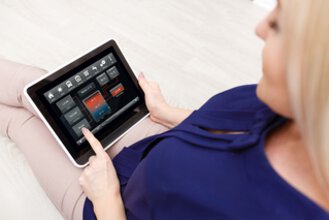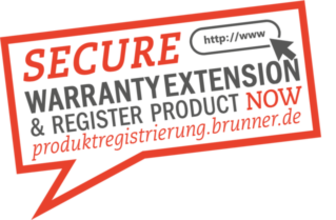Frequently Asked Questions
FAQ
You have questions - we have the answers
Here you will find a list of common questions from customers, which we have made for you. You will certainly find the answer here. Should you still have an unanswered question that is causing you sleepless nights, please feel free to contact us.
The unique atmosphere of a wood fire is still the cosiest and most pleasant heat source. It has accompanied people for thousands of years. At the same time, wood is a natural, renewable raw material whose combustion does not release any harmful flue gases or toxins. This is another reason why more and more people are heating their entire homes with wood. Regardless of the effects of global political crises, regional wood removal is strictly regulated and controlled. A home to feel good in, all with a clear conscience. This is exactly what fireplaces, tiled stoves and boilers by Brunner stand for.
Our products are only available from qualified specialist dealers. Experienced stove and heating installers guarantee that the installation of our high-quality products also runs smoothly. In this way, we can offer the best quality and excellent service for decades.
People's buying behaviour is leading them further and further towards online retailing and consequently there are now also some retailers who sell BRUNNER products on their online shop. Legislation does not allow us to prevent this, but we do not support it. We are firmly convinced that only systems built by trained experts promise the quality that BRUNNER wants to offer, and we only provide a guarantee on products that have been installed by qualified tradesmen.
Because we simply love the raw material of wood and our nature. And that is why we are convinced that wood heaters and wood fires are the perfect contribution to a healthy and sustainable environment.
To be able to keep our promise of quality, all our products are manufactured 100% in Germany. Our cast-iron heating inserts for tiled stoves and our cast-iron fireplace inserts of the "IRON DOG" series, for example, are manufactured in our own ironworks in Ortrand, Saxony. Our fireplace inserts are produced in Landshut, Bavaria. And our boilers come from the Bavarian forest. Before all these products are delivered to the craftsman, we receive them on our test bench where they are checked manually by our experienced technicians.
We find it important to be able to stand by the quality of our products. And this is only made possible by this elaborate but valuable production chain.
You don't have to. That's what we're here for. Just go to www.brunner.de/de/orientierung and try out our innovative Inspirator. It will help you get an overview of which of our products is best for you.
A masonry or storage heater is a type of tiled stove construction-type in which the energy produced in the combustion chamber is released into the room with a delay of several hours. The combustion takes place in a masonry combustion chamber. The heating gases flow through the draught channel of the heat storage, which charges like a "heat accumulator". This energy load is slowly released across the surface as gentle radiant heat. When planning, the furnace builder determines the heat output across the stove surface and the wall thickness temperature. The storage capacity is influenced by the weight.
The hot-air stove is a type of tiled stove in which the energy released during the combustion phase is quickly converted into heat. A free-standing cast iron heating insert with lateral metal reheating surface is placed in the stove cladding. The room air flowing in through openings in the base area heats up on the hot surfaces and flows as convection air, usually through ventilation grilles, into the installation room.
Rated heat power is the effective heat delivered to the living space. Combustion heat power is the heat released by the fuel in the firebox. Especially in the case of stove systems with large storage volumes, where the energy is released with a delay over a long period of time, the rated combustion power and the rated heat power can differ significantly.
Sealing cords consist of E-glass or silicate fibres. They are heat-resistant and harmless to health.
Ceramic glass does not expand when heated - therefore no stresses build up in this material. There is no danger of stress cracks or breakage even when it cools down quickly. Ceramic glass can be loaded up to 700 degrees Celsius. At higher temperatures, the glass becomes milky cloudy; however, the strength is not significantly changed by this.
Viewing glass faces are best cleaned with a damp (not wet!) paper towel. Stubborn dirt can also be removed with a damp paper towel dipped in a little wood ash. Avoid cleaning agents or special foam cleaners. Their ingredients attack the oven seals on contact and are damaging.
Since various factors play a role here (for example, chimney height, sea level, heating insert output and design, etc.), no general statement can be made regarding the cross-section. The specialist tradesman must always carry out a chimney calculation. Guide values: For tiled stoves at least 16 cm, for fireplaces at least 18 cm in diameter, open fireplaces require between 25 and 30 cm.
Only untreated split logs including adhering bark are suitable and permitted for combustion in individual fireplaces. The logs must be stored until the moisture content has reached a maximum of 20 percent. Coated, varnished or treated wood must not be burnt.
It is best to store firewood loosely stacked in piles, if possible in sunlight, well ventilated and protected against rain. Unsuitable is the storage of wood in damp, closed rooms without ventilation.
The stainless furnace is ideal for wood fuel, but not for coal. Coal needs combustion air from below into the stack while being able to shake off the embers and remove ash. Therefore, coal cannot be burnt. In addition, the fireclay is specially designed for wood; if coal is burnt, the fireclay will be damaged in a short time. But wood briquettes according to DIN 51731, size class HP2,may be used at any time.
You can find information about firewood here: www.firewood.com.
Logs and/or wood pellets are used as environment-friendly fuels for tiled stove central heating systems. With pellets, the tiled stove central heating system can be operated fully automatically. This guarantees the highest heating comfort and at the same time independence from fossil fuels.
In buildings with a low energy demand, the entire heat, heating and hot water demand can be generated by a tiled stove central heating system. This eliminates the costs for an additional heating device.
The negative pressure safety control (USA) is required if the negative chimney pressure must be monitored. This is always the case if the pressure conditions in the installation room or in the combustion air system of the fireplace are influenced by ventilation systems such as extractor hood, living room ventilation, hoover system or clothes dryer. As soon as the negative pressure in the chimney falls below the minimum value, the ventilation system, extractor fan etc. are deactivated. With the USA, any number of ventilation units can be connected (maximum permissible switching capacity 2A). However, only one fireplace can be monitored.
BRUNNER combustion and stove controls not only ensure greater ease of use (place the wood on the stove, light it and you no longer need to worry about the rest of the combustion process), they also contribute to a special level of safety. To avoid any safety hazards, the stove must not be in any operating condition. EOS and EAS monitor all components. Safety-relevant components such as the door contact switch are duplicated or equipped with additional sensors. Only if both signals match, the component is working according to regulations. The safety concept always requires feedback. This is unique and only available at BRUNNER’s.
The term tiled stove is always used among experts when referring to stoves - especially tiled stoves. Ceramic components are produced in a special production process, and their special geometry makes that they are fixed in place with clamps during construction. Tiles, on the other hand, are flat slabs fired from white clay and painted or printed. They are mainly used as wall and floor coverings in kitchens or bathrooms.
The German law has set deadlines for the decommissioning / replacement of old appliances: If the limit values in the transitional CO emissions and particulate matter regulations cannot be demonstrably met, the appliances must be retrofitted or taken out of operation. The date depends on the date on the type plate of the appliance.
Date on type plate Date of retrofitting or decommissioning
up to and including 31 December 1974 31 December 2014
(or date no longer ascertained)
1 January 1975 - 31 December 1984 31 December 2017
1 January 1985 - 31 December 1994 31 December 2020
1 January 1995 to 21 March 2010 31 December 2024
The type plate on the stove, fireplace or wood fire insert shows the type and model. With this type plate, you can check on the HKI (Industrieverband Haus-, Heiz und Küchentechnik e.V.) website http://www.cert.hki-online.de/ whether and when the tiled stove replacement or the renewal of the system is necessary. If the device lacks a type plate, the manufacturer can provide information or the chimney sweep can help.
If the heating insert was put into operation after 22 March 2010, it fulfils the requirements of the amended 1st BImSchV and can continue to be operated without conditions and for an unlimited period of time.
The manufacturer's declaration contains the information on the date of replacement.
If there is no manufacturer's declaration or test certificate for compliance with the limit values, the law provides for the following alternatives to appliance replacement or decommissioning:
- Individual inspection/measurement by chimney sweep (dust: 0.15 grams per cubic metre, carbon monoxide: 4 grams per cubic metre)
- Fireplace inserts, tiled stove inserts or comparable walled-in stove inserts can be retrofitted with a downstream device to reduce dust emissions according to the state of the art.
Important note:
- proving the limit values by a measurement of the chimney sweep is not always possible and can also be negative.
- the installation of a so-called "dust filter" is costly. Dust filters must be serviced regularly according to the manufacturer's instructions.
Alternative measures should be evaluated in relation to the age of the fireplace. They are a solution if fireplace inserts, tiled stove inserts or comparable stove inserts are firmly walled in.
The law has exempted the following fireplaces from the obligation to be replaced, retrofitted or decommissioned:
• non-commercially used cookers and ovens with a rated heat power of less than 15 kW
- open fireplaces
• hand-built basic stoves
• single-room combustion systems in residential units where the heat is supplied exclusively by these systems and no other heating system is present (e.g. radiators).
• Single-room furnaces which can be proved to have been manufactured or erected before 1 January 1950.
In the case of a tiled stove with a reheating box that needs to be replaced, we also recommend the replacement of the metal reheating surface. In this case, it must be decided on a case-by-case basis whether the measure is possible in view of the installation situation and geometry without the necessary dismantling of the tiled stove housing - i.e. the effort is worth it
Strictly speaking, the tiled stove insert is type-tested together with the reheating box according to DIN EN 13229. In the case of a replacement, the metal reheating box must also be renewed. Replacing the heating insert without the reheating box is only possible if the reheating box is compatible with the new heating insert and the exchanger surfaces are approximately the same. Heating boxes made of cast iron with a wall thickness of at least 4 mm or steel/stainless steel sheet with a wall thickness of at least 2 mm are suitable.
Basically, the situation on site and the technical condition of the reheating box must be considered. In case of doubt, it is better to replace the tiled stove heating insert together with the reheating box.
The retrofitting of the existing heating insert via so-called retrofit kits is described as a possible solution in the 1st Federal Immission Control Ordinance (BImSchV). A retrofit kit can consist of baffle plates, ceramic foam, etc. for the replacement of functional parts. When offering such retrofits, the manufacturer shall be responsible that the values of the test report for emissions and efficiency are met after the retrofit. The retrofitted fireplace must have been type-tested by the manufacturer and entitled to bear the CE mark.
The authorised district chimney sweep must be involved before the "retrofit". The responsibility lies with the manufacturer of the fireplace. The installation of the retrofit kit must not be carried out by the manufacturer but by a specialist company. Afterwards, the approval is carried out by the authorised district chimney sweep.
Note: Before 2001, heating inserts were tested according to national DIN standards (e.g. DIN 18892). The old DIN test specifications stipulated test intervals of six years. In specific cases, retrofitting of combustion chamber components is required for devices that have been tested at a later stage, so that they do not have to be exchanged.
The installation of a retrofit kit should be evaluated in relation to the age of the fireplace. It is a solution if fireplace inserts, tiled stove inserts or comparable stove inserts are firmly walled in and the replacement is disproportionate in terms of effort.
Before 2001, heating inserts were tested according to national DIN standards. The test had to be repeated every six years. The last test carried out for the heating insert is decisive as long as there are no significant design changes.
These facts are documented and stored in the HKI database. The date of exchange is found here.
Open fireplaces or openly operated wood fireplaces are not classified as heating appliances by the German law. The fireplaces are not affected by the obligation to replace them. They may continue to be operated, but only occasionally.
The interpretation of the indeterminate legal term "occasional operation" includes various official specifications and legal decisions:
• Berlin Supreme Court. Restriction of operation to one day a week for six hours (judgment of 26 March 2013, case no. 21 U 131/08)
• Higher Administrative Court of Rhineland-Palatinate in Koblenz (1991). Restriction of operation to eight days a month for five hours (resolution of 12 April 1991, ref.: 7 B 10342/91).
The listed mandates, however, cannot be regarded as a nationwide general standard. In principle it is forbidden to use the open fireplace regularly as a permanent heating of living space.
In order to ensure the most uniform enforcement of the 1st Federal Immission Control Ordinance (BImSchV), various questions were answered by the Federal Government/Länder Immission Control Working Group (LAI). These answers, guidance for implementation and notes are coordinated within the Länder immission control authorities. These interpretations are recommendations the federal states may deviate from. In individual cases, fuel ordinances in large cities or conurbations restrict the provisions of the Federal Immission Control Ordinance (BImSchV) for the operation of wood fire stoves.
· In Munich only wood fireplaces that comply with stage 2 of the 1st Federal Immission Control Ordinance (BImSchV) may be operated.
- In Stuttgart, special regulations apply to the operation of wood fireplaces during "fine dust alarms".
The replacement or retrofitting of a heating insert is a substantial modification of the fireplace according to the 1st Federal Immission Control Ordinance (BImSchV). This means:
1. in virtue of the 1st Federal Immission Control Ordinance (BImSchV) BImSchV:
a) the discharge conditions (chimney) must be re-evaluated according to §19 of the 1st BImSchV and
b) proof of compliance with the valid requirements for this fireplace according to Annex 4 of the 1st Federal Immission Control Ordinance (BImSchV) must be available.
2. in virtue of the building law:
a) the above-mentioned requirements must be proven by type tests from the manufacturer and
b) if necessary, further building regulations (e.g. safety distances to combustible materials) be complied with.
c) the fireplace may only be put into operation after the due certification of the suitability and safe usability of the combustion system (according to the model building code (MBO)) or the flue gas system (according to the state building code (LBO)) by the authorised chimney sweep.
